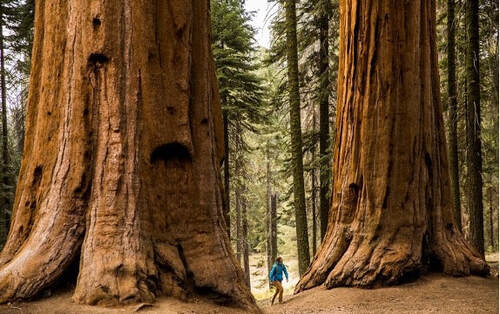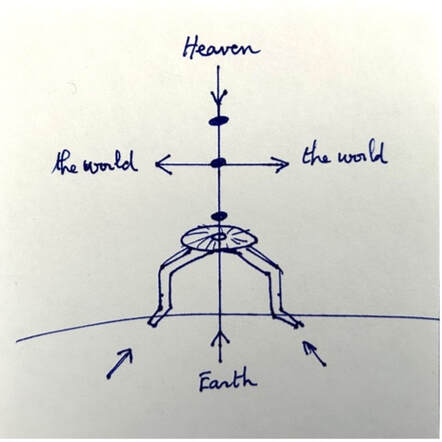This paper provides background information on a well-known martial arts stance, the horse stance, and explains the proper way to practice it. General information on martial stances, including the horse stance, can be found in another paper, Stances in Martial Arts (https://aikidodavis.com/blog/stances-in-martial-arts).
What is the Horse Stance
The horse stance is a key element of basic training in many martial arts originating from Asia. It owes its name to the position of the legs which resembles that of a horse rider spreading the knees to accommodate the trunk of a horse. Its most obvious purpose is to strengthen the lower body, that is, hips and legs. There are other less apparent yet more substantial reasons to practice this stance on a regular basis that we will explain below.
Why Practice the Horse Stance
The spiritual connection
Sentient beings are created by heavenly intelligence ingeniously combining various earth elements; hence the natural tendency of these beings is to reach back to their creative sources, heaven and earth, for sustenance. Witness, trees grow vertically downward to absorb the nutrients of the soil, and vertically upward to soak in the nourishment from sunlight and air. Scientists know this phenomenon as geotropism (or gravitropism): roots of plants gravitate naturally downward toward the earth center, while the stem is drawn upward in the opposite direction toward the sun and air.

Giant Sequoias (Credit: Jordan Siemens – Getty Images)
Similarly, human beings are made by divine super-intelligence combining various elements of earth, and are naturally drawn toward the motherly source, the earth, for their physical sustenance, as well as toward the fatherly source, the heavens, for spiritual inspiration. Indeed, humans instinctively know to lie down on the ground to relax and reinvigorate; they also intuitively know to gaze far into the blue sky or starry firmament to get inspiration.
In the same vein, martial artists of old and other spiritual seekers discovered that they had better chance of success in their earthly endeavors when then plugged into these vast energetical reservoirs located at opposite poles, the amniotic sac of earth and the vast quantum field of potentialities of the heavens. They devised methods to root into these reservoirs, and one of them is the practice of stances, such as Zhan Zhuang (standing like a pole/tree). Of these stances, the Horse Stance was the most basic and the most down to earth (literally).The energetic connection
A proper horse stance channels the energies of heaven and earth through the central energetic core and nourishes the energetic bodies (physical, etheric, celestial, causal, etc.) of a human being. That is, the correct physical stance aligns the bodies (physical and energetic) of the human being such that the central pole becomes an antenna that exchanges electromagnetic energies with the earth and the universe. The horse stance in particular favors the exchange with earthly energies that nourish and strengthen the physical and lower energy bodies, while also receiving and transmitting other higher frequency energies to a lesser extent. The horse stance is the stance that builds the martial artist from the ground up and helps him maintain this energetic connection throughout the movements.
This continuous connection with the earth allows the martial artist to continuously channel earth’s energy upward through the legs, store it in the hips and discharge it through the upper limbs toward the target.
Stance training in martial arts generally starts with the horse stance then bifurcates into two branches: the external martial arts train with asymmetric stances representing the typical forms of such arts, while the internal martial arts prefer training with symmetric stances focusing on the development of the energy centers, such as the Zhan Zhuang stance of holding a ball in front of the chest.
In order to derive benefits from the Horse Stance, one does not need to understand how the energetical exchange takes place; one just need to hold the stance correctly, as explained below. As in most inner practice, once we have made the decision to engage into it, we should remove our petty self and refrain from interfering with the working of Nature; we just need to stand and be aware, and not try too hard.
Stand with the feeling of receiving energies from heaven and earth through the central axis, anchored in earth through the legs, while ready to connect with the above-ground environment through the extended arms.
The impression should be that one is rooted into the sources of primal energies and recharging the Self, while holding the outer world at bay with the extended arms. Consistent practice will create a natural space, a buffer zone, between the Self and the world, that spawns a sense of detachment from worldly affairs, and promotes inner peace.

Rooting in Heaven and Earth.
The mental training
Standing still in the horse stance for fifteen minutes while the body is aching and struggling to maintain balance is a mental challenge. Yet people have done it, and it takes a lot of discipline. The hardest part is not caused by the body, but by the weak mind that is running afoul, conflicted between the need to give in to the tired body, and the desire to hold the stance longer.
One solution is to focus the mind (awareness) on feeling various parts of the body and releasing unnecessary stress. In the long term, the practice of the horse stance allows one to build endurance and improve mental focus, as well as instilling a disciplined character.The physical imperatives
The strength of a martial art is derived from fluid movements of the body as a well-grounded unit. However, stability and fluidity are sometimes conflicting goals, until one finds a way to train for both. Such an approach has been known by ancient martial traditions: it consists of building a strong center that is supported, and can be moved quickly, by strong legs. The strong central axis allows the body to consolidate its energy and move as one unit, whereas the strong legs foster fluid motion. The horse stance trains for both imperatives, as explained below.
Standing consciously still and relaxed for long duration allows the muscular and soft tissue structure to reorganize, separating the muscles and tissues that are needed for motion from those that are needed for stability; those that are idle will drop and hang from the active ones. With continued practice, the muscles and tissues that are necessary for the stance will gradually find the perfect alignment to deal with gravity. The long-term result is that the body eventually discover an axis in its median line that supports, and connects with, all other parts. This is the central axis, which rallies all parts of the body during motion.
The low height in the horse stance strengthens the muscles and tissues of the hips and legs, which form the support structure for the central axis. For example, one can feel the lower back and the quads muscles aching in a prolonged stance. The strengthening of its support structure allows the central axis to move fluidly and to immediately anchor when the movement stops.
How to Hold the Horse Stance
A proper horse stance has these principal characteristics:
- The back is vertical, with the head lifted at the crown, and the hips gently tucked in.
- The thighs are within 45 degrees from horizontal.
- The shins are vertical with the knees directly on top of the ankles.
- The feet are relaxed and spread evenly on the ground; feet can be parallel in advanced practice.
- The arms rest on the hips or extend forward with elbows down.
- The body is as relaxed as possible, especially at the neck and shoulders.
- The pelvic floor is generally relaxed and open, allowing for a round crotch.
- The breath is smooth and slow in the abdomen.
Muscles will be aching in the beginning; however, the most challenging ongoing hurdle is our mind, which rebels at the stillness. The best way to overcome this is to constantly scan the body from top to bottom for any tension that needs to be released and for proper alignment.

The Horse Stance
Daily Practice
The horse stance is a regular long-term practice. Below are guidelines for daily practice.
- Start with limbering up the body with stretching.
- Find a solid and flat surface nearest to the ground, away from major distractions.
- Hold the stance with thighs at 45 degrees for one minute.
- After a week of daily practice increase the duration by 15 seconds.
- Aim for daily sessions of 5 minutes in the long run. Experienced students can aim for 10 minutes or more.
- After achieving the 10-minute threshold, add the challenge of a lower stance but do not go beyond horizontal thighs.
Constantly monitor the health of the lower back and hips area and adjust the practice accordingly.
Caution
The horse stance imposes a hefty demand on the lower back and hip structure. Training that is prolonged beyond natural capability will result in harm to the body. As with any internal energy practice we advise moderation and incrementalism.
Go up to 70% of capability and gently push that 70% threshold incrementally. Rushing this practice will only worsen it.
It should also be noted that, because it is intrinsically an energetic practice, students can achieve higher level during intense group practice which are imbued with elevated consciousness. However, it is not advisable for a student to replicate such feat during an individual practice session.
Conclusion
All human beings, whether involved in martial arts or not, can benefit from the practice of the horse stance. It is a relatively easy and safe exercise that promotes health and calm; trees do it all the time. For humans, a daily dose of horse stance and correct walking are the most salubrious physical activities.

Leave a Reply